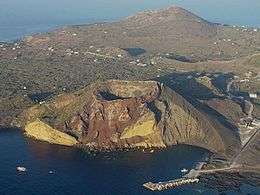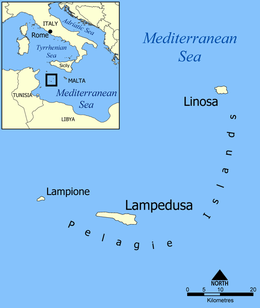Linosa
 | |
 | |
| Geography | |
|---|---|
| Location | Mediterranean Sea |
| Coordinates | 35°52′N 12°52′E / 35.867°N 12.867°ECoordinates: 35°52′N 12°52′E / 35.867°N 12.867°E |
| Archipelago | Pelagie Islands |
| Area | 5.4 km2 (2.1 sq mi) |
| Administration | |
|
Italy | |
| Region | Sicily |
| Province | Agrigento |
| Comune | Lampedusa e Linosa |
| Demographics | |
| Population | 433 |
Linosa (Sicilian: Linusa) is one of the Pelagie Islands in the Sicily Channel of the Mediterranean Sea.
The island is a part of the comune of Lampedusa e Linosa, part of the province of Agrigento, Sicily. It has a population of 430.
Name
The island is cited first as Greek Aethusa "Αἰθοῦσσα" by Strabo and Algusa "Ἀλγοῦσσα" by Pliny the Elder in his Naturalis Historia. The name "Lenusa" appeared first during the 16th century in the writing of Tommaso Fazello while the modern one date back to 1845 used by the Knight Bernardo Maria Sanvinsente.
Geography
The island has an area of 5.45 square kilometres (2.10 sq mi) and is of volcanic origin. It is formed by a series of craters of which Monte Vulcano, 195 metres (640 feet) high, is the most important. The closest land to Linosa is the island of Lampedusa, which lies 43 km (27 mi) to the south. Linosa is situated 119 kilometres (74 miles) west of Gozo, Malta, 121 km (75 miles) southeast of Pantelleria, 163 km (101 mi) south of Sicily and 165 km (103 mi) east of Cape Mahida in Tunisia.
History
During the Punic Wars it was used by the Romans as a base; the 150 water cisterns remaining are from this period. Roman domination was followed by Saracen, Norman, Angevin and Aragonese control. The island remained deserted until 1843 when Ferdinand II of the Two Sicilies ordered Knight Bernardo Maria Sanvinsente, captain of frigate, to colonize the island. The first thirty colonists (artisans from Ustica, Agrigento and Pantelleria) with the addition of a major, a priest and a doctor, landed on 25 April 1845.
During World War II, a small Italian garrison surrendered[1] to a British force from HMS Nubian on the morning of 13 June 1943.
Few were interested in the island during the Kingdom of Italy and only in the 1970s did the island begin to change, with technological innovations and the development of tourism. The first telephone exchange was installed in 1963, the first power station in 1967, and a new school with a nursery in 1968. In 1983 the building of a desalinization plant provided a constant supply of potable water.
Economy
Linosa's population subsists on fishing, agriculture and tourism.
Gallery
.jpg) Linosa
Linosa Typical house in Linosa
Typical house in Linosa- Linosa landscape of the coast in the area of so-called "Faraglioni"
- Landscape of volcanic rocks
See also
References
External links
| Wikimedia Commons has media related to Linosa. |